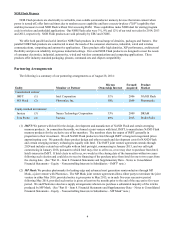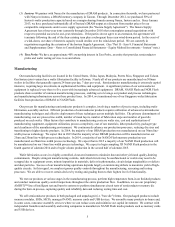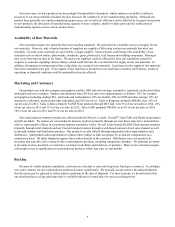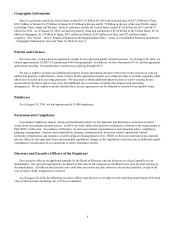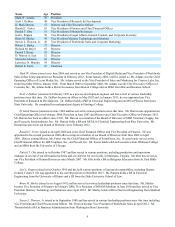Crucial 2014 Annual Report Download - page 16
Download and view the complete annual report
Please find page 16 of the 2014 Crucial annual report below. You can navigate through the pages in the report by either clicking on the pages listed below, or by using the keyword search tool below to find specific information within the annual report.14
Following a series of hearings with pleadings, arguments and witnesses on behalf of the Qimonda estate, on March 13,
2014, the Court issued judgments: (1) ordering Micron B.V. to pay approximately $1 million in respect of certain Inotera
shares sold in connection with the original share purchase; (2) ordering Micron B.V. to disclose certain information with respect
to any Inotera Shares sold by it to third parties; (3) ordering Micron B.V. to disclose the benefits derived by it from ownership
of the Inotera Shares, including in particular, any profits distributed on such shares and all other benefits; (4) denying
Qimonda’s claims against Micron Technology for any damages relating to the joint venture relationship with Inotera; and (5)
determining that Qimonda's obligations under the patent cross-license agreement are cancelled. In addition, the Court issued
interlocutory judgments ordering, among other things: (1) that Micron B.V. transfer to the Qimonda estate the Inotera Shares
still owned by it and pay to the Qimonda estate compensation in an amount to be specified for any Inotera Shares sold to third
parties; and (2) that Micron B.V. pay the Qimonda estate as compensation an amount to be specified for benefits derived by it
from ownership of the Inotera Shares. The interlocutory judgments have no immediate, enforceable effect on us, and,
accordingly, we expect to be able to continue to operate with full control of the Inotera Shares subject to further developments
in the case. We have filed a notice of appeal, and the parties have submitted briefs to the appeals court. A hearing on the matter
is scheduled for February 2, 2015.
We are unable to predict the outcome of the matter and therefore cannot estimate the range of possible loss. The final
resolution of this lawsuit could result in the loss of the Inotera shares or equivalent monetary damages, unspecified damages
based on the benefits derived by Micron B.V. from the ownership of the Inotera Shares, and/or the termination of the patent
cross-license, which could have a material adverse effect on our business, results of operation or financial condition. As of
August 28, 2014, the Inotera Shares had a carrying value for purposes of our financial reporting of $505 million and a market
value of $2.06 billion.
Our future success depends on our ability to develop and produce competitive new memory technologies.
Our key semiconductor memory technologies of DRAM, NAND Flash and NOR Flash face technological barriers to
continue to meet long-term customer needs. These barriers include potential limitations on the ability to shrink products in
order to reduce costs, meet higher density requirements and improve power consumption and reliability. To meet these
requirements, we expect that new memory technologies will be developed by the semiconductor memory industry. Our
competitors are working to develop new memory technologies that may offer performance and/or cost advantages to our
existing memory technologies and render existing technologies obsolete. Accordingly, our future success may depend on our
ability to develop and produce viable and competitive new memory technologies. There can be no assurance of the following:
• that we will be successful in developing competitive new semiconductor memory technologies;
• that we will be able to cost-effectively manufacture new products;
• that we will be able to successfully market these technologies; and
• that margins generated from sales of these products will allow us to recover costs of development efforts.
If our efforts to develop new semiconductor memory technologies are unsuccessful, our business, results of operations or
financial condition may be materially adversely affected.
New product development may be unsuccessful.
We are developing new products that complement our traditional memory products or leverage their underlying design or
process technology. We have made significant investments in product and process technologies and anticipate expending
significant resources for new semiconductor product development, including system-level memory products, over the next
several years. The process to develop DRAM, NAND Flash, NOR Flash and certain specialty memory products requires us to
demonstrate advanced functionality and performance, many times well in advance of a planned ramp of production, in order to
secure design wins with our customers. There can be no assurance that our product development efforts will be successful, that
we will be able to cost-effectively manufacture new products, that we will be able to successfully market these products or that
margins generated from sales of these products will allow us to recover costs of development efforts.


